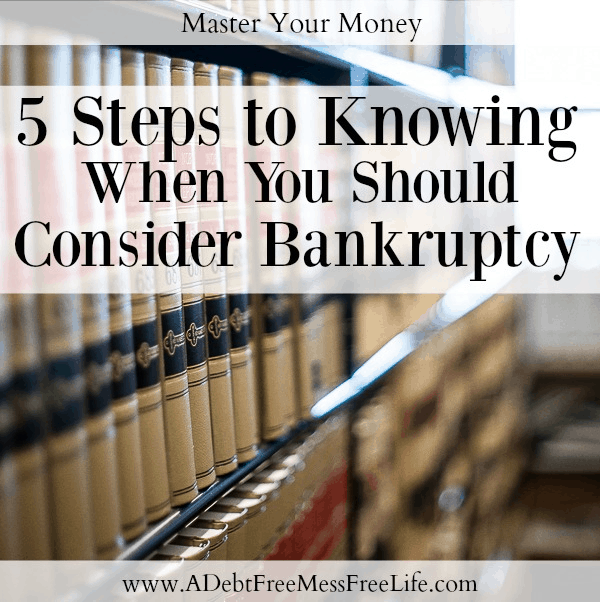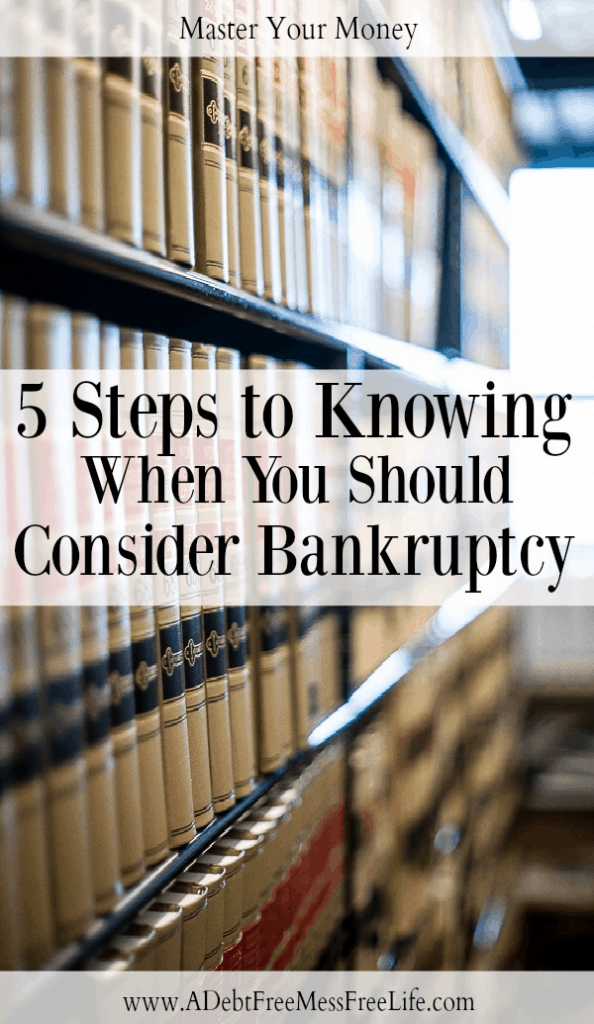A Mess Free Life may collect a share of sales or other compensation from the links on this page.
Today’s guest post is from Darlene Daniel, Attorney at Law who specializes in bankruptcy issues. Bankruptcy enables people who are delinquent in financial obligations to legally discharge (wipe out) their debts, often with little or no negative consequences. She can help determine if you qualify under the Chapter 7 “means” test, or if you will need to file for a Chapter 13 reorganization to repay debts over time.
Table of Contents
5 Steps To Knowing When You Should Consider Bankruptcy
Thanks to public service announcements, most of us are familiar with the warning signs of a stroke: slurred speech, crooked smile, loss of balance to name a few. But the warning signs for financial difficulty are usually the “elephant” in the room: no one really talks about it, and you don’t want to talk about your financial troubles with your friends and family.
Sure, there are plenty of courses that provide useful information on real estate investing and retirement planning; but, before you invest and plan for your future, you need to assess your financial health. April is tax time and tax season is a perfect time to take stock of your financial situation, especially if you are experiencing the following “warning signs”:* Living from paycheck to paycheck* Struggling to pay the minimum on credit cards every month
* Borrowing from friends and family to “tide you over” until the next month
* Using a credit card, or home equity line of credit, to pay for necessities such as groceries and utilities
* Using one credit card to pay the monthly payment on another
* Having nothing set aside for an emergency, such as a major car repair or medical bill
* Having no budget in place, and just “winging it” every month
Some of these are obvious, but the situation can sneak up on you, and before you know it, you can’t pay your bills on time without considering whether or not to buy groceries for the week. This is not the position you want to be in, but you need to take control of the situation before it takes control of you.
Follow these 5 steps to figure out whether you need to consider bankruptcy.
Step 1: Look At Monthly Income and Expenses
This is usually a very painful dose of reality for most of us, but it’s the only way to realistically assess your financial picture, and set up a budget. There’s no way to assess your finances unless you take this initial step.
The income side is usually straightforward, unless you are self-employed, or do seasonal work. On the expense side, only list monthly payments for rent/mortgage, utilities, groceries, student loan payments, car payments, insurance, etc. Do not list any discretionary expenses like vacations, eating out, and charitable contributions. This doesn’t mean that you will eliminate all of these expenses in your final budget; for now, you want to know what the “bottom line” is for all necessary expenses.
Deduct your expenses from your income-this is your “Bottom Line”.
Step 2: List All Credit Card Debt, Medical Bills, Personal Loans
List all of your credit card debt, medical bills, and personal loans, and add the payoff balances. You may want to pull a free credit report at annualcreditreport.com to verify the balances and see if there are any other debts lurking out there. This is a painful exercise, but I promise you will feel better knowing this figure. This is your “Discretionary Debt”.
Step 3: What’s The Bottom Line
Look at the “bottom line” in Step 1. Do you have money left over after necessary expenses? If you do, you’re still not “out of the woods”. Proceed to Step 4. If you have nothing (or less than zero) left, proceed to Step 5.
Step 4: Determine If You Can Repay In Five Years
The general rule is that, unless you can repay 60% of your debts in 5 years, you should consider bankruptcy. Here’s the formula:
- Take the figure from Step 2, and multiply it by .6 (i.e. 60%)
- Take that figure, and divide it by 60. This is your “Monthly Debt Payout”.
If your Monthly Debt Payout in Step 4 is more than your Bottom Line in Step 1, you can probably avoid bankruptcy, and work out a debt consolidation plan through a non-profit credit counseling company.
If the figure in Step 4 is less than the figure in Step 1, (or the result in Step 3 is less than zero), you need to strongly consider bankruptcy.
Proceed to Step 5.
Step 5: Take A Deep Breath and Don’t Panic
If the result in Step 3 or Step 4 steers you towards considering bankruptcy, you still have other non-bankruptcy options:
To solve your budget shortfall, you need one of 2 things: more income, or fewer expenses. Can you get a part-time job to supplement your income? Rent a room in your house? Can you cut back on eating out, vacations, and charitable giving? Are you willing to mow the lawn this summer, and not hire the landscaper?
If increasing income or reducing expenses isn’t an option, or it won’t give you enough income to “balance your budget” in Step 4, consider bankruptcy.
Filing bankruptcy is a major life decision. Working with a qualified attorney well versed in bankruptcy law is crucial in helping you make an informed decision. Make sure whoever you consult shares both non-bankruptcy and bankruptcy options to you, so that they can make a decision that is the best interest of you and your family.
The most common reaction clients have once they have filed for bankruptcy is “I feel like I’m in control again”. So, take control of your financial situation, and get back in the “driver’s seat”.
Attorney Darlene Daniele graduated from Suffolk University Law School and began her career as a member of the Massachusetts Bar. Her experience has been in a small firm setting, handling matters which range from real estate conveyancing to personal injury to bankruptcy. It’s her mission to deliver exceptional legal services to the local community while providing solutions to the complex challenges of the law. It is our desire to create a less intimidating experience by taking the burden off you. Personal service, responsiveness, and accessibility are what separates her from other firms. For more information visit her web page Salem Legal Services.
MY FAVORITE MONEY-SAVING TOOLS
EBATES: Want to earn cash back when you shop online? Ebates acts as a shopping portal offering coupons and cashback from over 2,000 online stores. I always check on Ebates first whenever I shop online! You can join Ebates for free and get a $10 welcome bonus when you sign up through this link.
DIGIT: Like the idea of saving but need something automatic? Digit is the perfect solution if trying to automate your savings strategy. In essence, what Digit does is use an algorithm to detect spare money and then transfers it to a secure savings account – so you’ll always have something to fall back on. Sign up for free!
GROCERY BUDGET MAKEOVER: Is your grocery budget giving you a serious kick in your families spending plan? Grocery Budget Makeover helped my family slash $6,000 a year from our food bill! Learn more about how Grocery Budget Makeover can help you save money too!




